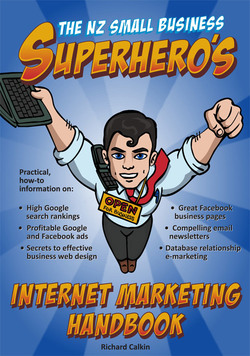Read the following excerpt from my book ‘The NZ Small Business Superhero’s Marketing Handbook’ and find out how to create persuasive content for your website…
The brain is fixated with solving problems. If your perfect prospect identifies with a problem that you can solve for her, you will get her attention immediately.
This is why problem-focused headlines are often more effective than benefit-focused headlines. Consider the following examples:
Benefit-focused headline: Make permanent and positive changes to achieve the important things in your life!
Problem-focused headline: You know it. If you don’t make changes, you’ll be stuck for the rest of your life!
By identifying and highlighting the problem, you will get the attention of anyone who has personal experience of that problem. Once you have their attention, you can outline your solution. For more information on how to identify the key problems and create content that will motivate your prospects to engage with you and take action, read The Brain Audit by Sean d’Souza (www.thebrainaudit.com). This brilliant book takes a jargon-free look at the psychology of buying and what persuades customers to buy, and is well worth a read.
One of the most fundamental factors that separates dull, boring copy from writing that leaps off the page and engages the reader relates to how well the content puts the customer at the heart of the story. Don’t tell them about you and what you do and how long you have been in business. Don’t talk about you and what’s important to you.
Most websites make this mistake. Instead talk about your prospect and what’s important to them. As much as possible the content should create mental images and stories of happy customers experiencing the benefits promised by the client’s business, rather than droning on about how great the company is. Focusing on benefits (which are about the customer) rather than features (which are about the company or the product) avoids what persuasive web content gurus Jeffrey and Bryan Eisenberg refer to as “we-we”.
Many websites are full of “we-we”: in other words content that talks about the company and their products and services, rather than about the customers’ needs. Every time you find yourself talking about we, our, or us, turn it around and talk about you, your and yours. In this way you will be forced to talk about the topic from your prospect’s perspective. The Eisenberg brothers’ website has a We-We calculator that allows you to analyse a page’s customer focus. Simply enter the page’s URL into the calculator at: www.futurenowinc.com/wewe.htm for an insight into how customer-focused your page’s content is.
To read more, you can purchase my book ‘The NZ Small Business Superhero’s Internet Marketing Handbook’ by clicking here.

